Hemen Arayın : 0 542 4310154 Engin KARABULUT
CANON 430 EX DİGİTAL FLAŞ
Guide Number: 43m (141 feet) at 105mm setting (ISO 100)
14mm/11m; 24mm/25m; 28/27; 35mm/31m; 50mm/34m; 70mm/37m; 80mm/40m; 105mm/43m
Coverage: 24mm-105mm (auto and manual zoom head) with 14mm drop-down panel
Flash Count: 200-1400 flashes (internal power)
Recycle Time: 3.7 sec (new alkaline batteries, full power)
Flash Range (at ISO100 with 50mm f/1.4): Normal flash: Approximately 0.7m - 24.3m
Exposure Compensation: -3 to +3 in 1/3 or 1/2 stop increments
Exposure Modes: E-TTL II (with compatible bodies), E-TTL (Type A cameras), TTL (Type B cameras) & FE Lock (E-TTL only)
Flash Modes: Normal, Stroboscopic Flash, High Speed Sync, Test Firing, Modeling Flash, 2nd Curtain Sync and Wireless Slave
Bounce Direction: Up: 0-90 degrees , Left:0-180 degrees , Right: 0-90 degrees
Bounce Direction: Up: 0-90 degrees , Left:0-180 degrees , Right: 0-90 degrees
Bounce Lock: 0 degrees up, left, right; 90 degrees up
Head: Auto and manual zoom with 90 degree bounce (up) and 180 degree swivel
AF Assist Light: Covers all 7 AF sensors of the Elan 7E, 10D, Rebel Ti, Rebel 2000 and Digital Rebel (partial coverage for EOS 1V or 3)
AF Assist Light Range: 7m for center sensor • 5m for periphery (I can often squeeze in another meter or two)
Batteries: 4 AA • Alkaline, Ni-Cd, Nickel-Hydride or Lithium
Weight: 330g (without batteries)
Size: 72mm (W) x 122mm (H) x 101mm (D)
Accessories: pouch, stand (with 1/4" socket) and instruction manual
Street Price: $250
Weary with your feeble popup flash? Fancy more range and flexibility in your flash unit? Maybe a 430EX Speedlite is in your future. Here's what your hard-earned $250 buys you:
- Maximum guide number of 43m (141 feet) at 105mm setting (ISO 100)
- E-TTL II, E-TTL or TTL flash metering depending on body used
- Autozoom flash head, 24-105mm with 14mm pulldown panel
- Color temperature information transmission with selected digital SLR cameras
- Near IR AF-assist beam compatible with 9 AF points or less
- Illuminated LCD screen
- Built-in slave receiver allowing use in an E-TTL wireless flash system
- Onboard controls for manual flash, flash exposure compensation (FEC) and 2nd curtain sync
- Manual flash output between 1/1 to 1/64 stop, adjustable in one stop increments
- 6 custom functions
- Swiveling head with stops at 0, 60, 75, 90, 120, 150, 180 degrees (left) or 0, 60, 75, 90 degrees (right)
- Bounce head with stops at 0, 45, 60, 75 and 90 degrees
Canon Speedlite 430EX mounted on stand
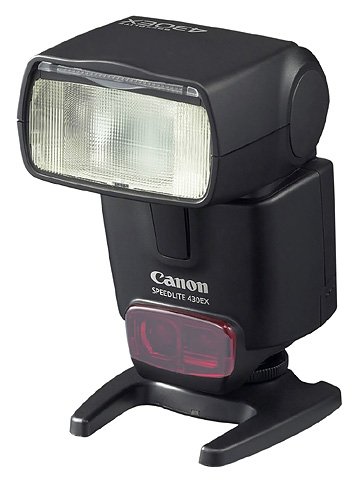
The 430EX is relatively small and light (330 g) for a powerful flash, perfect for travel and hiking. I power it with four AA lithiums to keep weight as low as possible. Although the 430EX is about the same size and weight as the 420EX, it certainly has more features. The obvious upgrade is the addition of a control panel with dedicated buttons and an illuminated LCD. The spartan 420EX requires onboard camera controls to access most advanced features. This arrangement was okay for most EOS bodies but some Rebel models lack controls for flash exposure compensation (FEC) and 2nd curtain sync.
Canon Speedlite 430EX rear panel • Full display of modes, functions and exposure data.

E-TTL Flash Metering
Press the shutter button and the 430EX emits a low power preflash to determine exposure a split second before firing. The preflash is so near the main flash it appears as a single flash rather than two. Normally the Evaluative meter pattern is used to measure both ambient light and flash (center weighted may be selected via CF in some bodies). In most modes the camera balances both flash and ambient light for a natural appearance. If you have an E-TTL II capable body, e.g., Elan 7NE or 20D, distance information and other scene information may also be factored into the exposure.
Venetian Ceiling Detail • EOS 10D, EF 17-40 4L USM, 430EX Speedlite, ISO 100, Tv Mode (29mm, F4, 1/60).
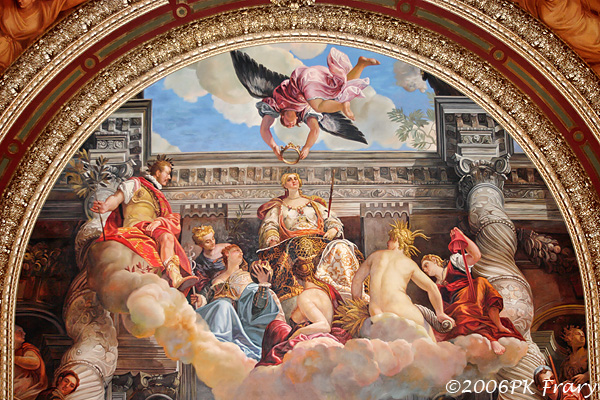
Fill-in Flash
In bright light, above EV 10, the 430EX provides automatic fill-in flash in Full Auto and P modes. In dim light, EV 10 and below, the flash provides the main light in Full Auto and P modes (the background may be dark). Av, Tv and M modes deliver automatic fill-in flash in any light, even at night (slow sync mode). Slow sync results in a natural balance between ambient light and flash. You may need a tripod due to the resulting slow shutter speeds in slow sync mode. Incidentally, the 430EX tends to produce a warmer color temperature in tungsten or mixed light than the 420EX. As main light flash it produces the normal slightly blue electronic flash look.
Agashi at the Venetian • EOS 5D, EF 24-105 4L IS USM & 430EX Speedlite. I shot wide open at F4 in Av mode, allowing the 430EX Speedlite to render auto fill-in flash, blending subject and background light. Amazingly, no flash compensation was needed. The flash head was manually zoomed to limit coverage to subject only (didn't want to illuminate the fence).
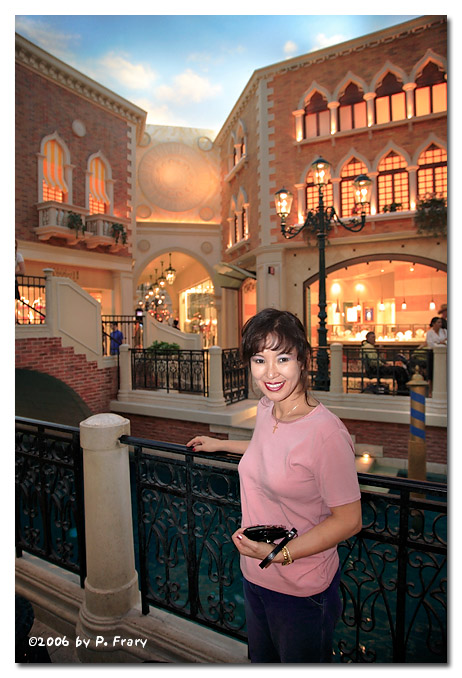
Strangely, in dim light, the 10D, 20D, Elan 7 series and other recent A-Type bodies reduce ambient exposure in slow sync mode (e.g., Av or Tv modes at night). In light dimmer than EV10, ambient exposure is progressively reduced, reaching -1 one stop by EV 7 or so (varies according to ISO). The EOS A2, Elan, Elan II and IX don't exhibit this odd behavior. Perhaps Canon underexposes ambient light to make flash lit subjects stand out? I'd rather have no exposure reduction. The photographer should make the choice themselves. If you'd like to know more about this phenomena, visit the folks at the EOS Documentation Project. They even gave it a name: Flash Negative Evaluative Exposure Compensation or NEVEC.
On E-TTL and TTL bodies (E-TTL II bodies behave a little different) the active focusing point is linked to metering and, thus, flash exposure. In other words, there is an exposure bias in favor of the object you focus on. This design implies you should avoid the lock-AF-recompose technique or suffer unpredictable results. Why? Flash exposure is determined at the moment of exposure (a split second before exposure for E-TTL and during exposure for TTL). If the active AF sensor is over something other than your subject--a black void--you'll get incorrect exposure. If you can't live without the lock-AF-recompose technique, Canon designed FE Lock for you (see below).
Canon EOS Elan • Photo taken with EOS 5D/24-105 4L IS USM, ST-E2, & 430EX Speedlite bounced into white reflector.
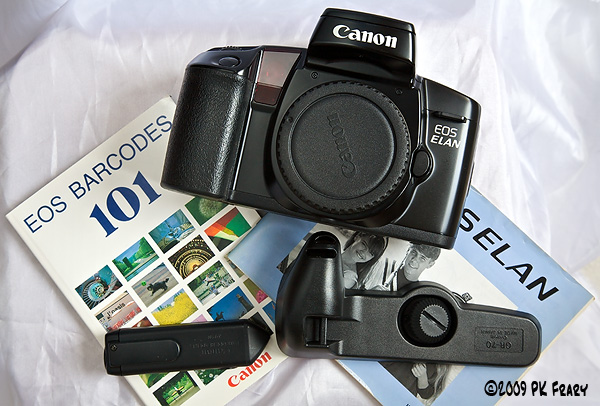
E-TTL II measures flash data across a flat plane rather than a point, unlike E-TTL and TTL, which were strongly biased to the active AF point. In some situations it may also factor distance information into the exposure calculation. Any any rate, these changes resulted in consistently excellent flash exposures with my E-TTL II enabled EOS 5D.
As I mentioned above, the 430EX balances flash and background light in Av, Tv and M modes. Program (P) and Full Auto modes are different. They also use flash as fill in bright light. However, in dim light (EV 10 or lower) flash becomes the main light--rather than fill--and the background is allowed to go dark. It's a deer-in-headlights-look (DIHL) but many shooters prefer the look and/or simplicity of P or Full Auto mode. It's simple because these modes insure hand holdable shutter speeds under all conditions. You merely point 'n shoot and get useable DIHL pictures.
View from Bellagio • EOS 5D, EF 24-105 4L IS USM, 430EX Speedlite, Av Mode (F4). I used manual AF point selection to insure an AF sensor locked on my subject.
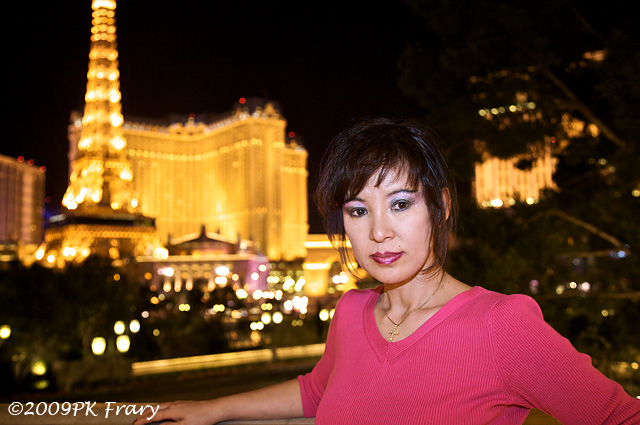
FE Lock (FEL) & Flash Exposure Compensation (FEC)
FE Lock (FEL) is great for off-center subjects or troublesome highlights that fool the meter. FEL works like a spot meter for flash. First, place the center AF sensor on your subject and press the AE/FE Lock button. The Speedlite fires a low power burst, a preflash. Exposure is determined by the reflectance of the subject in the partial metering circle, so be careful what you aim at. Use a medium toned area for best results. Finally, you have 16 seconds to recompose and shoot. The flash will expose the subject correctly even with usually light or dark backgrounds or an off-center subject.
Unfortunately, FEL isn't people friendly as few enjoy being flashed in the face once for metering and a second time for the exposure. If you shoot people images, you will be more popular if you apply appropriate flash exposure compensation and forgo FEL.
If you intend to use FEL on an unusually light or dark object, e.g., a white wedding dress, apply Flash Exposure Compensation (FEC) first because it doesn't work after FEL: subtract 1 to 2 stops of flash compensation for dark subjects and add 1 to 2 stops of flash exposure compensation for light subjects. Why? Spot or partial meters are calibrated to read 18% gray tones. No matter where you point, the camera expects a medium tone (18% gray) and gives you the correct meter reading for this result.
FP Flash
FP Flash allows you to sync at any shutter speed, albeit with loss of power. For example a 1/250 second exposure causes a loss of nearly half of the flash range on an Elan 7NE (normal sync is 1/125). However, this is great for daytime fill flash as it allows use of large apertures or fast film. FP Flash works best in Av, Tv and M modes where the user has control over aperture and/or shutter speed. When a Speedlite is mounted, P and DEP* modes are not shiftable making these modes almost useless for FP Flash. Moreover, P mode tends to favor smaller apertures over faster shutter speeds when a Speedlite is mounted. Second curtain sync does not work with FP Flash (high speed sync).
AF Assist Light
Instead of an irritating series of bright pulses, the 430EX emits a deep red focus pattern. Not only is it less alarming to subjects, it works much better as a focus aid. Focusing in the dark is quick and discreet. With the 430EX mounted, low light AF is vastly improved: my Elan 7NE and 10D will AF a blank wall in total darkness from nearly 30 feet away.
You can disable flash and use AF assist only by setting a Custom Function on many bodies, e.g., the Elan 7 series (CF7) and 10D/20D (CF5). Unfortunately, the EOS 3 and 1 series lack the CF to disable flash and use AF assist only (go figure!). It's not surprising the 430EX works perfectly--full coverage--with 9-point AF arrays such as the EOS 5D, 20D and 30D. What is surprising and unlike the 420EX, the 430EX sports full AF assist coverage of 45-point displays such as the EOS 3 or 1V.
The 430EX also rocks with the AF modes of the EOS 7D: 19 AF points in 19-point auto selection, zone and single point modes. In other words, I can select any individual AF point, including outer or upper points, the AF assist pattern projects and I get a focus lock. And, yes, it passes the dark room/blank white wall test: all individual AF points lock focus. My 5DII and 50D were not so fortunate. However the 430EX AF assist pattern is much brighter in the center than the outer areas, so I expect the center cluster to have more range. Like the 220EX, most of the advanced features are grayed out in the 7D flash menu (save FEC). Fortunately these features can be set on the flash itself.
Flash Exposure Confirmation Light
The 430EX has a flash exposure confirmation light next to the Pilot Light. If flash exposure is accurate, it glows green for 3 seconds. If it doesn't glow, move closer and try again.
Flash Exposure Averaging
If you disable AF on a 10D the E-TTL program averages the overall scene for flash exposures. Why? There is no active AF point to link to. Although this may not seem like a good ideal at first, it works better than normal flash metering in certain situations. For example, a light colored subject with a dark background averages to "medium" and results in a perfect flash exposure. If you use FEL or lock the active AF point on a white dress the result is 1.5 to 2 stops underexposure (the meter is expecting medium tones). Of course, an experienced photography knows to dial in FEC at that point, but flipping the AF switch to off may be a simpler solution for some. E-TTL II capable bodies such as the Elan 7NE , 20D and 5D employ a flash averaging algorithm with AF active.
If you use the Exposure Lock button (*) for AF (via custom function 4), AF is not linked to the active AF point. Instead, overall scene averaged flash metering is used.
Flash Compatibility
The 430EX is best suited for E-TTL/E-TTL II capable cameras but is compatible with older A-TTL/TTL capable EOS cameras in TTL mode only. TTL mode can't be used with E-TTL capable cameras. Why? Users can't toggle between E-TTL and TTL. Instead, the flash senses the camera model and automatically switches to the appropriate flash circuitry.



